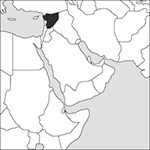
Source: MAPS IN MINUTES™ © RH Publications (1997)
Capital:
Damascus
Area:
185,180 sq km (71,498 sq miles)
Population:
22,457,336 (2005)
Currency:
1 Syrian pound = 100 piastres
Religions:
Sunni Muslim 74.0%; Alawi, Ismaili, and Shia 13.0%; Christian 10.0%; Druze 3.0%
Ethnic Groups:
Arab 90.3%; Kurdish, Armenian, and other minorities
Languages:
Arabic (official); minority languages
International Organizations:
UN; Arab League; OAPEC; Non-Aligned Movement; WTO
A country in the Middle East at the eastern end of the Mediterranean Sea.
Physical
Bounded on the north by Turkey, on the east by Iraq, on the south by Jordan, and on the south-west by Israel and Lebanon, Syria has a narrow coastal plain: citrus fruit and tobacco can be grown. Behind a range of hills the Asi (Orontes) River runs northward, along a rift valley; and beyond that the ground rises to a plateau. This merges into hot, dry desert, relieved only by the upper Euphrates, which runs across the country. In the extreme north-east there is oil.
Economy
Exports include crude oil and oil products, minerals, agricultural produce, cotton fibre, textiles, and clothing. The principal agricultural crops are cereals, cotton, pulses, olives, and sugar beet. The economy has been badly damaged by the civil war since 2011.
History
Syria was settled successively by the Akkadians, Arameans, and Canaanites, and formed a valuable province of successive empires, from the Phoenicians to the Byzantines. After the Arab conquest of the 630s, Damascus became the capital of the Arab caliphate under the Umayyads from 661 to 750, but subsequently Syria became a province of other rulers, such as the Fatimids and the Mamelukes of Egypt. It became a province of the Ottoman empire in 1516, and after the Turkish defeat in World War I Syria was mandated to France. Controlled by Vichy France at the outbreak of World War II, the country was invaded and occupied by British and Free French forces, and declared its independence in 1941. Political stability proved elusive, with three army-led coups in 1949 and others in 1951 and 1954. An abortive union with Egypt in the United Arab Republic provided no solution and was terminated by a further army coup. A leading political grouping, the Ba’ath Socialist Party, remained split by personal and ideological rivalries, though one successful and two abortive coups in 1963 did see a swing to policies of nationalization. Further coups in 1966 and 1970 saw the eventual emergence of General Hafiz al-Assad as the leader of a new regime, capable not only of crushing internal opposition but also of asserting significant influence over neighbouring war-torn Lebanon. However, Syria suffered major reverses in the 1967 Six-Day War and the Yom Kippur War of 1973 against Israel. It was deeply involved in the civil war in Lebanon (1975–89), and remained generally antagonistic towards Iraq, sending troops to defend Saudi Arabia in 1990 in the Gulf War. In December 1991 a reconciliation took place with the PLO, when Yasser Arafat visited Damascus. Relations with other Arab League states were improved and Syria took a cautious part in the Middle East peace negotiations of 1992. Unlike its former allies in the Six-Day War (Egypt and Jordan) Syria had not undertaken any rapprochement towards Israel. However, with the peace agreements between Israel and the PLO and Israel and Jordan (1993; 1994), President Assad made tentative moves to reach an accommodation with Israel. Assad died in 2000 and was succeeded as President by his son, Bashar al-Assad, who maintained his policies. Syria withdrew its troops from Lebanon in 2005 following accusations of involvement in the assassination of the former Lebanese Prime Minister Rafik Hariri. In 2011 popular protests inspired by the Arab Spring were met with state repression and by 2012 the conflict had escalated into full civil war. By 2014 about 100,000 people had been killed and several million displaced from their homes. That same year a further conflict developed between moderate rebel forces and the Sunni jihadist group Islamic State, which took control of large areas of northeast Syria. This prompted the USA and some other countries to intervene with aerial attacks on Islamic State, while the following year, Russia, Assad’s key ally, intervened to fight not only Islamic State but also all other opposition forces. With Russian support, Assad retook significant areas of the country. Despite many attempts, no ceasefire has yet turned into a convincing peace. By the end of 2016, the death toll exceeded 200,000 and 13.5 million Syrians (including six million children) required humanitarian assistance. Approaching five million were refugees in neighbouring countries and over 6.3 million were internally displaced. By December 2016 nearly 900,000 Syrians have travelled to Europe and claimed asylum there.
- Thailand
- Thailand Earth Observation System
- thalamus
- Thalassa
- thalassaemia
- Thalassinoides
- Thales
- Astraea
- astraeoid
- astragalus
- astration
- astrobiology
- astrobleme
- astrochemistry
- astrocyte
- astrodynamics
- ASTRO-F (Akari)
- astrogeology
- astrograph
- Astrographic Catalogue
- ASTRO-H
- astroid
- astrolabe
- astrometric binary
- astrometry